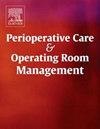地塞米松与右美托咪定对脊柱麻醉下剖宫产妇女寒战的影响
IF 1
Q2 Nursing
Perioperative Care and Operating Room Management
Pub Date : 2025-07-31
DOI:10.1016/j.pcorm.2025.100535
引用次数: 0
摘要
背景和目的术后寒战是脊髓麻醉相当常见的并发症。术后颤抖的管理包括可变的药理学和非药理学策略。本研究的目的是比较地塞米松和右美托咪定对选择性剖宫产妇女脊柱麻醉后寒战的影响。患者和方法382例患者随机分为两组,一组在分娩后立即静脉注射地塞米松10µg(组1),另一组术前2小时单次静脉滴注地塞米松8 mg(组2)。结局评估包括临床意义的术后寒战发生率、术后疼痛、使用首次抢救镇痛的时间和其他副作用,如低血压、心动过缓、镇静程度、术后恶心和呕吐。结果两组术后并发症比较,在寒战发生率(17.8% vs 12.6%, p = 0.15)、寒战严重程度(0/2/3级:82.2/7.9/ 10.0% vs 87.4/4.7/7.9, p = 0.61)、低血压(16.2% vs 23.0%, p = 0.09)、心动过缓(7.9% vs 12.6%, p = 0.13)、术后恶心呕吐(8.9% vs 6.3%, p = 0.22)方面无显著差异。此外,术后0、2、4、6、8 h的视觉模拟评分和镇静评分在实验组之间无显著差异。结论:本研究发现,右美托咪定和地塞米松在脊髓麻醉下用于女性CD患者时具有相当的疗效和安全性。本文章由计算机程序翻译,如有差异,请以英文原文为准。
Effect of dexamethasone versus dexmedetomidine on shivering in women undergoing cesarean delivery under spinal anesthesia
Background and aim
Postoperative shivering is a fairly common complication of spinal anesthesia. Management of postoperative shivering encompasses variable pharmacological and non-pharmacological strategies. The aim of the present study is to perform head-to-head comparison between the effects of dexamethasone and dexmedetomidine on shivering after spinal anesthesia in women undergoing elective cesarean delivery.
Patients and methods
The study included 382 patients randomized to receive either intravenous dexamethasone 10 µg immediately after delivery (Group 1) or single preoperative dose of dexamethasone 8 mg intravenous infusion in 100 ml normal saline 2 h preoperatively (Group 2). Outcome assessment included the incidence of clinically significant postoperative shivering, postoperative pain, time to use of first rescue analgesia and other side effects e.g. hypotension, bradycardia, sedation grade, and postoperative nausea and vomiting.
Results
Comparison between the studied groups regarding the postoperative complications revealed no significantly differences regarding the frequency of shivering (17.8 % versus 12.6 %, p = 0.15), severity of shivering (grades 0/2/3: 82.2/7.9/10.0 % versus 87.4/4.7/7.9, p = 0.61), hypotension (16.2 % versus 23.0 %, p = 0.09), bradycardia (7.9 % versus 12.6 %, p = 0.13) and postoperative nausea and vomiting (8.9 % versus 6.3 %, p = 0.22). Also, no significant differences were found between the studied groups regarding pain assessed by visual analog scale and sedation scores at 0,2,4,6 and 8 h postoperatively.
Conclusions
The present study found that both dexmedetomidine and dexamethasone had comparable efficacy and safety profile when used in women undergoing CD under spinal anesthesia.
求助全文
通过发布文献求助,成功后即可免费获取论文全文。
去求助
来源期刊

Perioperative Care and Operating Room Management
Nursing-Medical and Surgical Nursing
CiteScore
1.30
自引率
0.00%
发文量
52
审稿时长
56 days
期刊介绍:
The objective of this new online journal is to serve as a multidisciplinary, peer-reviewed source of information related to the administrative, economic, operational, safety, and quality aspects of the ambulatory and in-patient operating room and interventional procedural processes. The journal will provide high-quality information and research findings on operational and system-based approaches to ensure safe, coordinated, and high-value periprocedural care. With the current focus on value in health care it is essential that there is a venue for researchers to publish articles on quality improvement process initiatives, process flow modeling, information management, efficient design, cost improvement, use of novel technologies, and management.
 求助内容:
求助内容: 应助结果提醒方式:
应助结果提醒方式:


